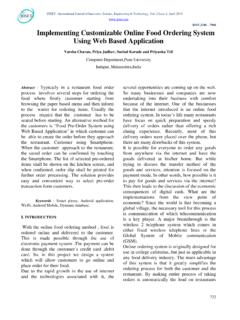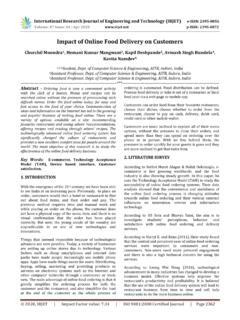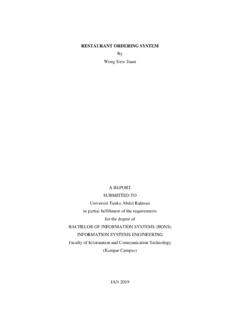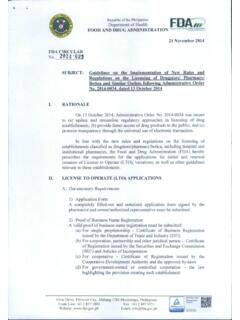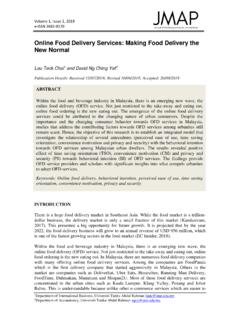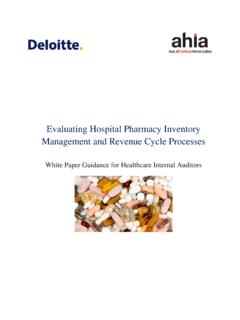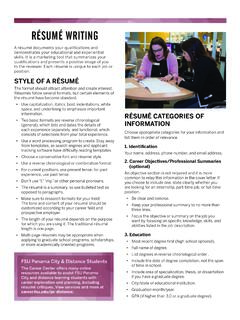Transcription of A Study of Stakeholders Perception of Factors Affecting ...
1 Proceedings of the 11th Annual International Conference on Industrial Engineering and Operations Management Singapore, March 7-11, 2021. A Study of Stakeholders Perception of Factors Affecting online food Delivery Service Industry in the Philippines SeonJae Lim and Marvin I. Noro a School of Industrial Engineering and Engineering Management Map a University, Manila, Philippines Abstract The online food delivery service is in the limelight nowadays as the O2O e-commerce industry is extending its range to the food . Beyond the food ordering system where only fast food was accommodated to be delivered to customer's doorstep, thousands of different foods from various restaurants can be delivered with just one click through the online food delivery (OFD) App. Together with its fast growth, it is inevitable to avoid some issues that happen among the major Stakeholders - the App firm, couriers, and customers. In this Study , the Business Model Canvas (BMC) and factorial Uni-variate analysis of variance (ANOVA) was used to identify the significant Factors that affect the OFD industry.
2 Using the tests of Between-Subjects effects, independent variables (Ease of Use, Responsiveness, Assurance, Safety, Reliability, Convenience) that has a value less than a p-value of were selected as the significant Factors . The Study showed from each of the stakeholder's approach that timeliness and convenience are the most significant Factors and suggested the improved integrated system based on the significant Factors identified. Finally, the Study would be able to contribute to the enhancement of the OFD. industry itself where all three Stakeholders can have mutually beneficial relationships. Keywords online food Delivery Service, timeliness, convenience 1. Introduction The convenience of using O2O platforms for e-commerce activities rode on the boom of smartphones and mobile applications with millions of downloadable from the Android Play Store, Google Play Store, and Apple Store ( online food Delivery Philippines: Statista Market Forecast, 2019).
3 This development and rapid adoption of mobile applications on smartphones changed consumers' buying habits and brand interaction (Kapoor and Vij, 2018) and has become a basic part of people's lifestyles, particularly on foodservice preference and food consumption. Regarding the emergence of new generation technologies, the situation during the COVID-19 outbreak forced the service providers to offer innovative ideas to limit human contacts for food delivery (Karim et al. 2020). As people stayed at their homes, they are more likely they use online food delivery services to avoid human contact. It gives the online food delivery service industry a great opportunity to increase demand during the pandemic (Kim et al. 2021). online food delivery service assists not only the customers by connecting them to courier to have the ordered item but also the couriers by reimbursing in his payment upon receipt of items at his doorsteps (Ray, et. al, 2019).
4 Moreover, the same Study cited that customers value the app features of ease-of-use, real-time tracking with the map, and suggested options upon restaurant search and fast and fresh food delivery, which were positively associated with intentions to use the food delivery service apps. During the service, it is inevitable to have issues on ordering and payment system and courier-related categories that will prevent the achievement of two main OFD achievements which are convenience and timeliness. It is in this light, that this research Study aims to explore what plausible changes in the business model and service operating system will benefit app firms, partner couriers, and customers collectively. IEOM Society International 5208. Proceedings of the 11th Annual International Conference on Industrial Engineering and Operations Management Singapore, March 7-11, 2021. Along with this overall aim, the Study intends to achieve the following objectives: 1.
5 To review and assess the business model and current practices Affecting the three major Stakeholders : app service firms, partner couriers, and customers;. 2. To determine the significant Factors that affect customer experience and partner courier relationships and transactions and;. 3. To develop an improved integrated system from order placement, order fulfillment or cancellation to payment of food delivery services incorporating business model reviews and stakeholder interests for mutually beneficial relationships. The research will provide insights on how to improve service quality, chain partners' collaboration, and customer retention with an innovation point of view, drawing away from the common approach in maximizing one's benefits to one that caters for the mutual benefit of the major Stakeholders of the foodservice delivery industry. Moreover, the undertaking can prompt policymakers and industry leaders to set the tone for change for the overall improvement in today's excellent value-seeking society with new generation technologies and emerging markets.
6 2. Methodology Conceptual Framework The main objective of the Study is to investigate the Factors behind major issues confronting foodservice delivery app firms, partner couriers, and end consumers or app users who are the three major Stakeholders of the industry to come up with an integrated system improve ordering , delivery, and payment processes for the mutual benefit of said Stakeholders . Thus, the following conceptual framework is drawn to guide the conduct of the Study : Figure Conceptual Framework Figure is the conceptual framework that explains the primary aim of this Study to determine the key Factors and drivers significantly Affecting the business model and operating system in the OFD industry that governs the mutual benefits of the Stakeholders of interest, namely the customers, courier partners, and App firms. There are six (6) independent variables which are Ease of Use, Responsiveness, Assurance, Safety, Reliability, and Convenience.
7 The business model and operating system are the intervening variables that work as a linking variable that connects the independent variables that are the dependent variable. Stakeholder's benefit is considered as a dependent variable in this Study . To be able to determine the significant relationships posited by the conceptual framework, testing of six (6) hypotheses was undertaken, to wit: Hn0: There is no relationship between each of the 6 Factors and stakeholder benefits. (where n = Factors ). Hna: There is a significant relationship between each of the 6 Factors and stakeholder benefits. (where n = Factors ). IEOM Society International 5209. Proceedings of the 11th Annual International Conference on Industrial Engineering and Operations Management Singapore, March 7-11, 2021. On the other hand, in determining the significant relationships for the above six (6) hypotheses, table , , and represents the following variables used in the conceptual framework.
8 Table Definition of variables (Customers). Latent Variable Code Description Reference Davis, Perceived Usefulness, Perceived EOU1 Well-presented app features through any devices Ease of Use, and User Acceptance of Information Technology. 1989. Ease of Use EOU2 ease of order placement Robey, User Attitudes and Management EOU3 presence of guidance if needed Information system Use. 1979. Sukartiko & Nugrahini, Identification RPS1 clear explanation from courier and restaurant of Technical Requirement for Improving Quality of Local online RPS2 courier route track food Delivery Service in Yogyakarta. 2018. Responsiveness Parasuraman, Zeithaml, & Berry, RPS3 courier update SERVQUAL: A Multiple-Item Scale for Measuring Consumer Perceptions of Service Quality. 1988. AS1 cash on delivery payment method Parasuraman, Zeithaml, & Berry, AS2 card delivery payment method SERVQUAL: A Multiple-Item Scale for Assurance Measuring Consumer Perceptions of AS3 compensation for wrong order Service Quality.
9 1988. SFTY1 well-maintained food temperature Aprilianti & Amanta, Promoting food Safety in Indonesia's online food SFTY2 fresh ingredients Delivery Service. 2020. Safety Wasserstrom, The 5 Biggest food SFTY3 well-maintained food packaging Delivery Risks. 2020. RLB1 affordable delivery charge Allyn, Restaurants Are Desperate - But Reliability RLB2 affordable food price You May Not Be Helping When You RLB3 well-guided aftersale system Use Delivery Apps. 2020. Lau & Yat, online food Delivery CV1 order anywhere Services: Making food Delivery the New Normal. 2019. Convenience Jiang, Jiang, & Liu, Consumer CV2 order anytime Perceptions of E-Service Convenience: An Exploratory Study . 2011. Parasuraman, Zeithaml, & Berry, Customer SERVQUAL: A Multiple-Item Scale for CB Good perceived quality of service Benefit Measuring Consumer Perceptions of Service Quality. 1988. Table Definition of variables (Courier). Latent Variable Code Description Reference EOU1 Well-presented app features through any devices Davis, Perceived Usefulness, Ease of Use Perceived Ease of Use, and User EOU2 ease of order placement Acceptance of Information Technology.
10 IEOM Society International 5210. Proceedings of the 11th Annual International Conference on Industrial Engineering and Operations Management Singapore, March 7-11, 2021. 1989. EOU3 presence of guidance if needed Robey, User Attitudes and Management Information system Use. 1979. Sukartiko & Nugrahini, Identification RPS1 clear explanation from customer and restaurant of Technical Requirement for Improving Quality of Local online food Delivery Service in Yogyakarta. RPS2 courier route track 2018. Responsiveness Parasuraman, Zeithaml, & Berry, RPS3 courier update SERVQUAL: A Multiple-Item Scale for Measuring Consumer Perceptions of Service Quality. 1988. AS1 cash on delivery payment method Parasuraman, Zeithaml, & Berry, SERVQUAL: A Multiple-Item Scale for Assurance AS2 card delivery payment method Measuring Consumer Perceptions of AS3 compensation for wrong order Service Quality. 1988. Safe delivery while carrying large amount of Aprilianti & Amanta, Promoting food SFTY1.
